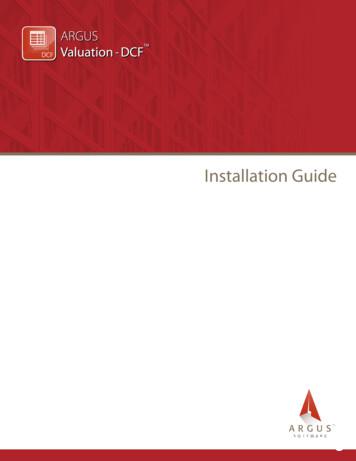GuruFocus User Manual: DCF Calculator
GuruFocus User Manual: DCF Calculator
Contents: 1. DCF Calculator Overview and Access 2. Using the DCF Fair Value Calculator 3. FAQs
1. DCF Calculator Overview and Access Unlike basic valuation ratios like the price-earnings ratio and the price-to-sales ratio, the discounted cash flow valuation model combines the company’s balance sheet value, future business earnings and earnings growth. As we will explore in this user manual, this valuation model can determine the company’s intrinsic value based on several factors. GuruFocus developed the DCF calculator so that you can estimate a company’s fair value by simply entering five inputs: the earnings per share, the future business growth rate, the terminal growth rate, the years of terminal growth and the discount rate. Accessing the DCF calculator You can access the DCF calculator in two ways: Under the Tools section of the blue ribbon, select “DCF Calculator.” Start from a company’s summary page. From the gray ribbon underneath the “ Add to Portfolio” button, click on DCF. Figure 1 shows how to access the DCF calculator, and Figure 2 displays the initial DCF Calculator screen. Figure 1
Figure 2 2. Using the DCF Fair Value Calculator As Figure 2 illustrates, the DCF Calculator contains several sections, including a fair value section, an input section, and an “Expect EPS Growth Rate (Reverse DCF model)” section. DCF Calculator Inputs Based on: You can either base the DCF calculation on a company’s TTM earnings per share or free cash flow. You can also enter a customized value by clicking on the pencil icon and entering a customized value. Discount Rate: The default discount rate equals the 10-year Treasury Constant Maturity Rate plus a 6% risk premium. You can enter a customized discount rate by clicking the pencil icon and entering the desired value. Tangible Book Value: Place a check mark to add the tangible book value to the DCF fair value. Growth Stage: The default values are 10 years of growth at the 10-year earnings / free cash flow growth rate. To change these values, either enter the desired years and growth rate or click on the /- buttons. Terminal Stage: The default values are 10 years of terminal growth at 4%. To change these values, either enter the desired years and growth rate or click on the /- buttons. To save customized parameters, click on the three-dots button and then the “Save Parameters” button as Figure 3 illustrates. Figure 3
Note: The Expected EPS / FCF Growth Rate table gives information on earnings and free cash flow growth rates. The expected growth rate gives the growth rate needed to justify the fair value of the stock. To edit or delete a custom set of parameters, select the set of parameters from the drop-down menu and then, click on the three-dots button. Figure 4.1 illustrates the drop-down menu while Figure 4.2 illustrates the edit and delete parameters menu. Figure 4.1 Figure 4.2
3. DCF Calculator Frequency Asked Questions (FAQs) Do we have to use the company’s earnings per share? o No. You can either use the earnings per share or the free cash flow per share in the DCF calculation. We use TTM EPS by default as earnings give a stronger correlation between intrinsic value and margin of safety than free cash flow does. o You can even use your own value for the “based on” parameter. o However, if you choose to use free cash flow per share in your DCF calculation, you must also use the FCF growth rate to maintain consistency. Why do you include the company’s predictability rank in the DCF Calculator? o The DCF model assumes that the projected earnings consistently grow at the 10-year rate listed. If a company’s predictability rank is less than two stars, the computed fair value may contain significant volatility. o In fact, the DCF Calculator warns you if the fair value may be inaccurate due to low predictability. You will see the following underneath the company’s fair value: Result may be inaccurate due to low predictability of business Do I need a premium membership to access the DCF Calculator? o You don’t need a premium membership to access the DCF Calculator. However, only premium and Premium Plus members can save parameters and view historical trend charts. I like your use of green and red for margin of safety on the DCF view and the growth rate on the Reverse DCF view. What is the meaning behind these colors? o For the DCF page, the margin of safety is green if positive and red if negative. o We highlight the reverse-DCF growth rate in green if the growth rate is below the company’s 10-year earnings growth rate and red if the growth rate exceeds the 10-year earnings growth rate. Green indicates a good sign while red indicates a warning signal. o You can also change the stock price in the “Fair Value” section to see how the margin of safety changes. You can also save your fair value by clicking on the “Save” icon next to the fair value as Figure 5 illustrates. The fair value will then save under the “My List” section of the Fair Value table. Figure 5
2. Using the DCF Fair Value Calculator As Figure 2 illustrates, the DCF Calculator contains several sections, including a fair value section, an input section, and an "Expect EPS Growth Rate (Reverse DCF model)" section. DCF Calculator Inputs Based on: You can either base the DCF calculation on a company's TTM earnings per share or free .
ARGUS Valuation - DCF, otherwise ARGUS Valuation - DCF may not run properly. ARGUS Valuation - DCF will be available in a folder in the Start menu and as a shortcut on your Windows desktop. When you launch ARGUS Valuation - DCF for the first time, you will be prompt
5 Scientific notation on your calculator 5.1 Inputting numbers in scientific notation to your calculator 6 Powers and surds on your calculator 6.1 Using roots on your calculator 6.2 Inserting a missing root 7 Trigonometric ratios on your calculator 8 Finding angles from trigonometric ratios 9 Radians on y
Cash Flow Output from ARGUS DCF Training While ARGUS DCF is able to generate future cash flow projections based on market factors and tenant rollover assumptions, a DCF valuation and sensitivity analyses are more easily controlled by using Excel. Additionally, a customized presentation of the property
The completed application must be received in a DCF office by the close of business on March 31st. Apply online at www.lieap.dcf.ks.gov Click on "Apply for Services" Click on "Energy Assistance" Questions, call 1-800-432-0043 Submit an application Mail to your local DCF office Fax E-mail
Data Capture Form newcastleis.co.uk. We have devised this form to assist you in capturing all . the information you need from your clients to enable . you to make an application to us online. DCF Version . 10 /2020. DCF Version . 10 /2020. 2. DCF Version . 10 /2020. WHAT TO SEND. Fees payable upfront with
Welcome to your HP 12c Financial Calculator This booklet is intended to get you started quickly with the basic features of your 12c Financial Calculator. Use it for quick reference. For more detailed information about the 12c Financial Calculator, refer to the HP 12c Financial Calculator User’s Guide. Pages of the user’s guide are
The pages of the HP 17bII Financial Calculator User's Guide are included for reference. Refer to these pages of the user's guide for more information. Table 1-1 Functions Display/Description Turn calculator on/off (page 17) To turn calculator on, press R. Note ON is printed below the key. The calculator turns off automatically 10
MINISTRY OF COMMERCE AND INDUSTRY (Department of Industrial Policy and Promotion) NOTIFICATION New Delhi, the 11th April, 2018 G.S.R. 364(E).—This notification is being issued in supersession of Gazette Notification No. G.S.R. 501(E) dated May 23, 2017. Definitions 1. In this notification,— (a) An entity shall be considered as a Startup: i .























